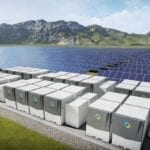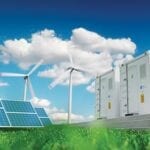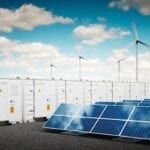Distributed energy resources (DERs) have become a major part of today’s power generation landscape. DERs are physical and virtual assets that are deployed across the grid. They are typically close to load, and can be deployed both in front of and behind the meter.
Bill Strohecker, Country Managing Director, Canada, for Hitachi ABB Power Grids, recently talked with POWER about DERs and how utilities should approach their use as they develop their power generation strategies, and adjust to the integration of renewable energy to the grid.
POWER: Should government policies, both at the state and federal level, continue (or begin) to support DERs, or should DERs compete on their own merits in the power markets?
Strohecker: From a cost-competitiveness standpoint, DERs can generally stand on their own, and this has increasingly been the case in recent years. However, there is a place for national and local (state and provincial) policies to help facilitate the smooth integration of these newer energy sources into the grid—this is particularly the case when it comes to larger-scale, more intermittent DERs. Existing regulations weren’t necessarily designed with DERs in mind. As a result, adjustments could be required to smooth the way for the integration of DERs and remove obstacles that may exist not just because of any particular intent, but also because the regulations in question were originally developed to guide a different kind of energy delivery model.
Also, traditional techniques such as the use of net metering and the adoption of favorable net metering rates can be used to stimulate adoption of DERs by residential and commercial users.

There are other benefits from DERs that governments may want to consider, apart from purely commercial considerations. For instance, because many natural gas-fired power plants have shut down in California, the state’s grid operator has warned of likely brownouts during this summer’s heatwave. Such brownouts could potentially be avoided or mitigated with adequate build out of DERs.
POWER: What should utilities be doing to support distributed energy resources? Should DERs be part of a utility’s portfolio, as part of a new and/or expanded business model?
Strohecker: I can’t speak to what utilities should or shouldn’t be doing nor to their business strategies, but I do expect they will ultimately be looking at DERs as a larger part of their supply mix. Countries and regions have been establishing aggressive sustainability goals and to meet them they are relying more heavily on renewable sources. DERs certainly can figure more prominently into that equation than they do today.
Of course, the reality is that smaller-scale DERs are not going to be enough to meet our increasingly ambitious sustainability ambitions unless consumers are encouraged to invest heavily in them, so utilities will need to look to or encourage large-scale renewable generation as a key element of their portfolio. With that in mind, utilities will need to continue to add large-scale generation sources like wind farms, bigger solar installations and hydro projects into the energy mix, along with smaller-scale DERs.
Utilities can also invest in and update their distribution management systems to better accommodate DERs. Distributed energy resource management systems (DERMS) are a growing practice area of utility enterprise software providers and machine learning (or artificial intelligence) that can be applied to optimize system performance.
Because many natural gas-fired power plants have shut down in California, the state’s grid operator foretold (the) brownouts during this summer’s heatwave. Brownouts can be avoided with adequate build-out of DERs.
POWER: Solar and wind power installations are increasingly being built at utility-scale. The use of residential solar power also continues to grow. Do you see this growth continuing, and if so, why?
Strohecker: Again, entities of all kinds (governments, companies, international institutions) have been establishing sustainability goals that can only be met by the widespread use of renewable generation. As such, we anticipate continued growth in renewable energy development of all kinds, from large-scale wind, solar and hydro to smaller-scale sources like rooftop solar, as we shift away from reliance on fossil fuels.
So, I expect to see continued growth across the board. Here in North America, we’re seeing the establishment of entirely new renewable sources like offshore wind, the development of which looks poised to take off in the U.S., particularly on the East Coast, in the relatively near future. Similarly, the U.S. and Canada are rich in development opportunities for large-scale solar, wind and hydro power resources. To take advantage of those opportunities, we need to be able to deliver this power from where it’s generated to the load centers where it is needed. This will require significant investment in additional transmission capacity and will necessitate the modernization of the power grid to support needed interconnections.
POWER: Should utilities, and also homeowners, be looking at integrating battery storage into solar and/or wind installations to increase reliability, resiliency, and flexibility?
Strohecker: Battery energy storage systems certainly have an important role to play, particularly when it comes to the integration of DERs into the power mix. As suggested, battery systems can be particularly helpful in bringing greater stability and consistency to systems that rely on intermittent power sources, such as wind. In recent years we’ve had quite a bit of success helping remote communities (including some First Nation communities in Canada)—that previously had to depend on diesel-powered generators for their electricity needs—transition to renewables, be it wind generation, hydro sources, solar or some combination thereof.
Battery storage could be more widely adopted with the modification of regulatory constructs in some jurisdictions across North America. Again and again, batteries could be applied for the ancillary services they can provide if regulations permitted it. Battery storage can be applied to more applications than just voltage support or frequency regulation, such as spinning reserve for example.
POWER: How much can/will battery storage contribute to the growth of DER adoption?
Strohecker: Efficient, intelligent and flexible energy storage is a necessity to support the continued growth in the adoption DERs. As important, these systems also help to provide greater access to electricity for those who are distanced from the main grid and enable them to wean themselves from the dependence on inefficient, costly and non-sustainable fuel sources.
Recent regulatory developments provide support for this view. For instance, in the U.S., a recent court decision upholding Federal Energy Regulatory Commission’s (FERC) Order 841, gives energy storage fair access to markets, unlocking new revenue opportunities for partners across the electric utility network. It also enables battery storage solutions, microgrids and other grid edge solutions to flourish by encouraging green initiatives and reliability.
POWER: Are there new technologies (other than battery storage) that you see as contributing to the growth of DERs?
Strohecker: As mentioned previously, microgrid technology (combined with energy storage systems) can complement and enhance grid operations and smooth the integration of DERs. We’ve found this combination to be uniquely beneficial for islands and remote communities seeking energy autonomy, but it also offers substantial benefits to utilities and service providers striving to effectively manage their increased portfolio of renewables and distributed energy resources.
—Darrell Proctor is associate editor for POWER (@DarrellProctor1, @POWERmagazine).










